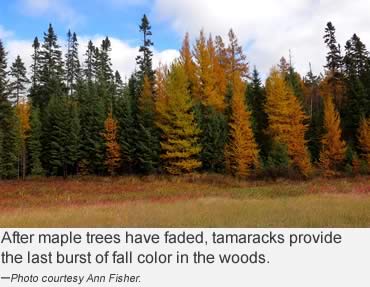When fall arrives and youngsters collect crisp, colorful fall leaves for their classrooms, leaves of a deciduous conifer are rarely displayed. That may be because the fall color that the needle-leaved trees produce arrives later in fall, after most deciduous trees have dropped their leaves.
All deciduous trees—oaks and maples, for example—have flowering plant growth patterns. They bud, bloom and drop their seeds. Maple helicopter seeds fly on spring air, and the oak’s acorns noisily drop every fall as do its leaves.
The word deciduous means to “fall off,” and it’s what soft-needled deciduous conifers have in common with their broad-leafed relatives.
Coniferous trees, or cone-bearing seed plants, keep their needles and their green color year-round, and that’s where it’s easy to become confused.
 Deciduous conifers may seem to be green all year round, but unless you’re watching a tamarack, cypress or dawn redwood throughout four seasons you may not notice the changes.
Deciduous conifers may seem to be green all year round, but unless you’re watching a tamarack, cypress or dawn redwood throughout four seasons you may not notice the changes.
About 33% of the United States is covered with trees, and the forest types vary, from the oak-hickory and maple-beech-birch forests of the North, to the pine forests of the South and the Douglas fir and ponderosa pine forests of the West.
Deciduous conifers share the same forest areas of the country. What they lack in quantity, they make up in unique qualities.
That’s because deciduous conifers share parts of both tree families. They grow from cones and have needles like conifer trees, but in fall their green changes into blazes of gold, orange, yellow and rust before they shed their needle-leaves for the winter. In spring, they leaf out and the growth cycle renews.
 Tamarack trees, also called American larch or hackmatack trees, are found in large stands in the eastern and northern United States and Canada. Bald cypress trees are found in the Southeast, with a range stretching from Illinois to Texas, in wet and dry lands. Dawn redwoods are present in giant sizes on the West Coast.
Tamarack trees, also called American larch or hackmatack trees, are found in large stands in the eastern and northern United States and Canada. Bald cypress trees are found in the Southeast, with a range stretching from Illinois to Texas, in wet and dry lands. Dawn redwoods are present in giant sizes on the West Coast.
Tamarack trees have a life span of about 180 years, sometimes more. They can reach 100 to 150 feet in height, and can survive extremely cold weather to -85 degrees Fahrenheit!
The name, tamarack, comes from an Algonquian word for the wood used to make snowshoes, and in Alaska, tamarack branches have been used as dogsled runners.
They are also known by foresters as valuable pioneer trees, because they readily seed or root-sprout on bare and poor soils, making them the first trees to form a new forest or grow in a damaged forest.
Find bald cypress in a larger range. They are native throughout the Southeast, Mississippi Valley and Gulf Coast, and grow on the coastal plane to mid-Atlantic states. The tree thrives in wet, swampy areas, and its protruding roots, which rise above water, are called “knees.” Scientists continue to debate if the knees take in air for underwater roots.
 The trees become old giants, growing up to 120 feet tall, with three- to six-foot wide trunks. They regularly reach up to 600 years in age. In mature cypress, the heartwood is highly valued for its rot-resistant qualities.
The trees become old giants, growing up to 120 feet tall, with three- to six-foot wide trunks. They regularly reach up to 600 years in age. In mature cypress, the heartwood is highly valued for its rot-resistant qualities.
Bald cypress grow at an extremely slow rate and are most often found along rivers and in wetlands, where they prevent erosion and soak up floodwaters. However, they can grow anywhere, and are also found in good health as far north as Canada.
Tamaracks, bald cypress and dawn redwoods provide the gifts of food and shelter for wildlife in every forest. So, take a look around this fall after most leaves have fallen. You’ll probably see a deciduous conifer ablaze with color.
–Resources: United States Forest Service, United States Department of Agriculture.